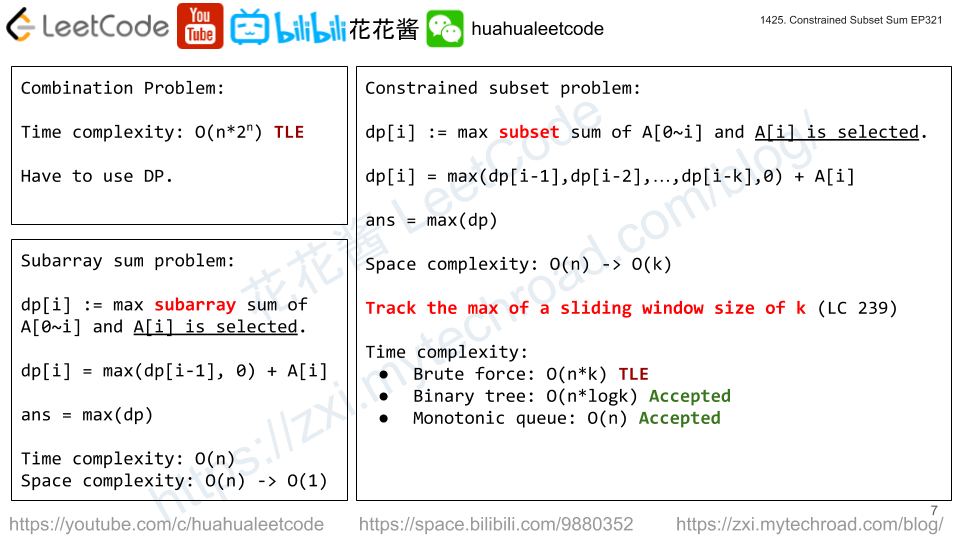Given an integer array nums and an integer k, return the maximum sum of a non-empty subset of that array such that for every two consecutive integers in the subset, nums[i] and nums[j], where i < j, the condition j - i <= k is satisfied.
A subset of an array is obtained by deleting some number of elements (can be zero) from the array, leaving the remaining elements in their original order.
Example 1:
Input: nums = [10,2,-10,5,20], k = 2 Output: 37 Explanation: The subset is [10, 2, 5, 20].
Example 2:
Input: nums = [-1,-2,-3], k = 1 Output: -1 Explanation: The subset must be non-empty, so we choose the largest number.
Example 3:
Input: nums = [10,-2,-10,-5,20], k = 2 Output: 23 Explanation: The subset is [10, -2, -5, 20].
Constraints:
1 <= k <= nums.length <= 10^5-10^4 <= nums[i] <= 10^4
Solution: DP / Sliding window / monotonic queue

dp[i] := max sum of a subset that include nums[i]
dp[i] := max(dp[i-1], dp[i-2], …, dp[i-k-1], 0) + nums[i]
C++
|
1 2 3 4 5 6 7 8 9 10 11 12 13 14 15 16 17 |
// Author: Huahua class Solution { public: int constrainedSubsetSum(vector<int>& nums, int k) { const int n = nums.size(); vector<int> dp(n); multiset<int> s{INT_MIN}; int ans = INT_MIN; for (int i = 0; i < nums.size(); ++i) { if (i > k) s.erase(s.equal_range(dp[i - k - 1]).first); dp[i] = max(*rbegin(s), 0) + nums[i]; s.insert(dp[i]); ans = max(ans, dp[i]); } return ans; } }; |
Use a monotonic queue to track the maximum of a sliding window dp[i-k-1] ~ dp[i-1].
Time complexity: O(n)
Space complexity: O(n)
C++
|
1 2 3 4 5 6 7 8 9 10 11 12 13 14 15 16 17 18 19 20 21 |
// Author: Huahua 184 ms class Solution { public: int constrainedSubsetSum(vector<int>& nums, int k) { const int n = nums.size(); vector<int> dp(n); deque<int> q; int ans = INT_MIN; for (int i = 0; i < nums.size(); ++i) { if (i > k && q.front() == i - k - 1) q.pop_front(); dp[i] = (q.empty() ? 0 : max(dp[q.front()], 0)) + nums[i]; while (!q.empty() && dp[i] >= dp[q.back()]) q.pop_back(); q.push_back(i); ans = max(ans, dp[i]); } return ans; } }; |
请尊重作者的劳动成果,转载请注明出处!花花保留对文章/视频的所有权利。
如果您喜欢这篇文章/视频,欢迎您捐赠花花。
If you like my articles / videos, donations are welcome.



Be First to Comment